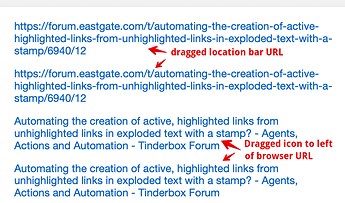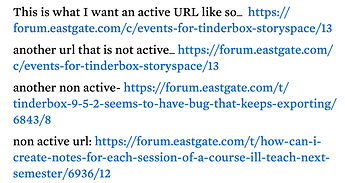I get the same, I used @sumnerg’s file but couldn’t re-create the result of every other drag not creating a link (I deliberately followed the demo in dragging the same link in case duplication was some edge case error (I don’t think that is so). There will be some other contextual subtlety about how the process occurs. In context I did note (see grab):
I the first two cases I dragged (in Safari app, under macOS 12.6.8) the location bar URL to Tinderbox $Text. In the next two I dragged the icon to the left of the URL which appears to result in the HTML <title> being used as anchor text to the note. I’m sure there are similar ambiguities when using webpage body copy rather then the page source URL as the drag source. Roll in different browsers and macOS version and doubtless unexpected hilarity ensues.
But this strays from the OP’s use case, which does reproducibly fail (to detect URLs via action code). There is no way to tell Tinderbox to (re-)detect explicit (pseudo-)URLs in $Text other than via manual, per-URL, edits after the Url. the most common edit is to type a Return and then backspace. This manual intervention triggers the URL detection/link adoption.
Oddly, if I use the starting demo as the original $Text, using the manual edit hack to adopt the URLs as web links before exploding, i.e so the start $Text is like this:
Then on explode only some notes (in most cases all except the first new note) retain the source web-links in the new note text.
The new problem, given the constantly variable results is figuring out where in the process links are (re-created). IOW, it’s not really testable by a user—other than to show inconsistencies—as we don’t know what trigger condition we are testing.
Circling back around, Explode does seem to retain RTF styling but now (consistently) Tinderbox or web links in the source text. However, I can’t find a source for the inconsistent result. SoI guess the question becomes. How does explode handle links in the source and how does it handle if at all valid URLs in the new note that are plain text in the source?
I’m probably not the only one who’s a bit confused. I wonder if we should split @sumnerg’s problem into a separate thread. although arising out of trying to workaround the OP’s problem, I think it is a different issue. To be clear, I’m not trying to spike one or the other, but I think they are discrete issues to resolve.

